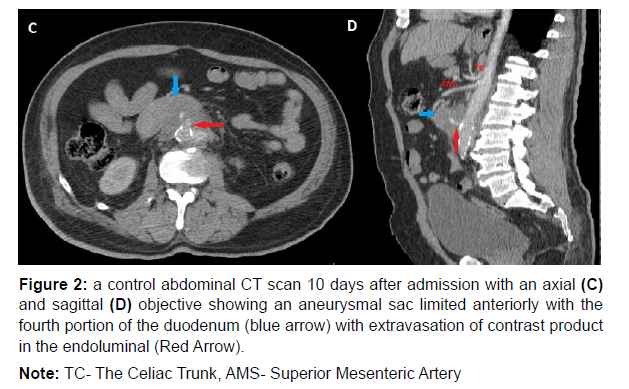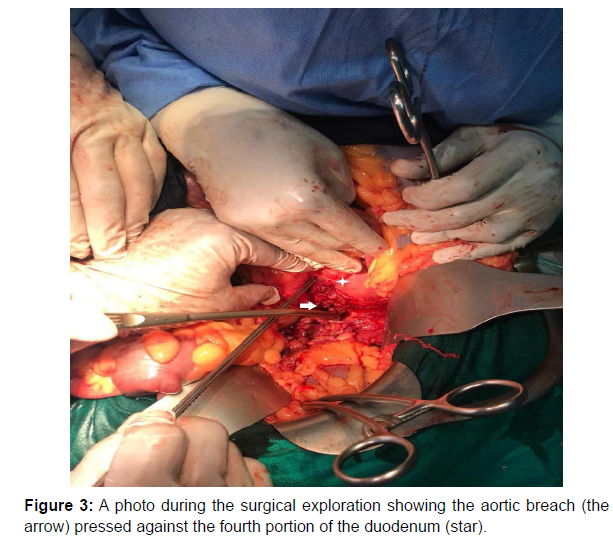Ruptured Abdominal Aortic Mycotic Pseudoaneurysm with Aortoenteric Fistula
Received: 04-Jun-2022 / Manuscript No. roa-22-65842 / Editor assigned: 06-Jun-2022 / PreQC No. roa-22-65842 (PQ) / Reviewed: 20-Jun-2022 / QC No. roa-22-65842 / Revised: 23-Jun-2022 / Manuscript No. roa-22-65842 (R) / Published Date: 30-Jun-2022 DOI: 10.4172/2167-7964.1000388
Abstract
Mycotic Pseudoaneurysms of the aorta are rare pathologic units accounting for 0.7 to 1.3% of infectious aneurysms of the aorta. Bacterial agents are the most frequently involved, while fungal agents are rare, occurring in areas of immunosuppression. The radiological diagnosis is essentially based on the five CT signs: the presence of the aneurysm sac, inflammation of the periaortic spaces, the absence of thrombi and aneurysmal wall calcifications and rapid growth. The main complication is aortic rupture with septic and hemorrhagic shock.
Keywords
Pseudoaneurysm; Aortoenteric fistula; Radiology
Introduction
Mycotic Pseudoaneurysms (MPAs) are rare pathological units representing 0.7 to 1.3% of aortic aneurysms. It is a surgical emergency with increased risk of fatal complications including rupture and aortic fistula enteric.
Case Report
This is a 50 years old diabetic and hypertensive man who consulted for a prolonged fever for two months with diffuse abdominal pain. The first-line ultrasound examination hampered by aerocoly did not show any abnormality. Suspect, an abdominal CT was requested which showed a fibro-inflammatory infiltration around the sub-renal portion of the abdominal aorta with some satellite nodes (Figure 1), a retroperitoneal fibrosis was evoked and the patient was put on corticosteroid therapy to reduce the inflammatory syndrome. 10 days after admission, the patient presented with severe metrorrhagia and the evolution was marked by the rapid onset of severe hypovolemic shock, the patient was put under conditions with stabilization of his hemodynamic state and a second CT scan was asked who objectified a retroperitoneal paraaortic collection limited in front by the fourth portion of the duodenum with individualization of an extravasation of contrast product (Figure 2) compatible with a mycotic pseudo-aneurysm ruptured in the duodenum, Le patient underwent surgical treatment (Figure 3) with large debridement of infected tissue and arterial reconstruction. A week after the operation the patient died and the autopsy was refused by the family. The most likely pathogenic mechanism in our case is aortic infection by inoculation of an atheromatous intima during bacteremia (Figures 1-3).
Note: TC- The Celiac Trunk, AMS- Superior Mesenteric Artery
Discussion
Infectious aortic aneurysms, also called mycotic aneurysms, are rare pathological units representing 0.7 to 1.3% of aortic aneurysms it is a surgical emergency with increased risk of rupture and severe sepsis responsible a high mortality rate of 16 to 40% even after surgery [1].
The term mycotic is used to designate any aneurysms of infectious origin, whatever the germ involved, this name dates back to 1885 by Sir William Osler who introduced the term mycotic for the first time to describe the appearance of fresh mushrooms (fresh fungal vegetations) of an aortic aneurysm complicating bacterial endocarditis. As well as the term aneurysm here is used to designate any aortic dilation of infectious origin, regardless of its size [1-3].
MPA can occur according to four mechanisms: Infectious microemboli in vasa vasorum, infection of an atheromatous intima by an infectious agent circulating during a bacteremia, infectious arterial involvement by extension of a focus contiguous infectious and ultimately direct infectious inoculation by trauma to the arterial wall. Pseudoaneurysm is the focal blood collection limited by surrounding tissue secondary to arterial rupture, unlike true aneurysms which involve all three layers of the arterial wall (intima, media and adventitia) [3-5].
Bacterial agents are the most frequently involved in particular Gram-positive Cocci (Staphylococcus aureus, streptococci, enterococci) and Gram-negative bacilli (Salmonella), fungal agents are rare causes occurring in areas of immunosuppression (Corticosteroid therapy, Immunosuppressant, Chemotherapy, Diabetes and Alcoholism) and atheromatous pathology remains the main risk factor for mycotic aneurysms [6-9].
The clinical presentation is variable and nonspecific explaining the frequent diagnostic delay ranging from a prolonged fever with a pulsatile thoraco-abdominal mass to a surgical complication, in particular aortic rupture or fulminant sepsis, biologically it results in a manifest biological inflammatory syndrome with a hyperleukocytosis, an increase in sedimentation rate and C-reactive protein [9-12].
References
- Raymond A, Fairise A, Ropion-Michaux H, Mathias J, LaurentV et al. (2011) Imagerie des anévrismes infectieux (mycotiques) de l’aorte abdominale. Feuillets de radiologie 51: 288.
- Macedo TA, Stanson AW, Oderich GS, Johnson CM, Panneton JM, et al. (2004) Infected aortic aneurysms: imaging findings. Radiology 231:250-257.
- Lin MP, Chang SC, Wu RH, Chou CK, Tzeng WS (2008) A comparison of computed tomography, magnetic resonance imaging, and digital subtraction angiography findings in the diagnosis of infected aortic aneurysm. J Comput Assist Tomogr 32: 616-620.
- Bennett DE (1967) Primary mycotic aneurysms of the aorta. Report of case and review of the literature. Arch Surg 94: 758-765.
- Kaufman SL, White Jr RI, Harrington DP, Barth KH, Siegelman SS (1978) Protean manifestations of mycotic aneurysms. AJR Am J Roentgenol 131:1019-1025.
- Muller BT, Wegener OR, Grabitz K, Pillny M, Thomas L, et al. (2001) Mycotic aneurysms of the thoracic and abdominal aorta and iliac arteries: experience with anatomic and extra-anatomic repair in 33 cases. J Vasc Surg 33: 106-113.
- Oderich GS, Panneton JM, Bower TC, Jr Cherry KJ, Rowland CM, et al. (2001) Infected aortic aneurysms: aggressive presentation, complicated early outcome,but durable results. J Vasc Surg 34: 900-908.
- Miranda S, Janvresse A, Plissonnier D, Levesque H, Marie I (2010) Anévrismes infectieux de l’aorte. A` propos d’une se´rie de dix patients. La Revue de Médecine Interne 31: 255-261.
- Nakata Y, Shionoya S, Kamiya K (1968) Pathogenesis of mycotic aneurysm. Angiology 19: 593-601.
- Gonda Jr RL, Gutierrez OH, Azodo MV (1988) Mycotic aneurysms of the aorta: radiologic features. Radiology 168: 343-346.
- Miller DV, Oderich GS, Aubry MC, Panneton JM, Edwards WD (2004) Surgical pathology of infected aneurysms of the descending thoracic and abdominal aorta: clinicopathologic correlations in 29 cases (1976 to 1999). Hum Pathol 35: 1112-1120.
- Gomes MN, Choyke PL, Wallace RB (1992) Infected aortic aneurysms. A changing entity. Ann Surg 215: 435-442.
Indexed at, Google Scholar, Crossref
Indexed at, Google Scholar, Crossref
Indexed at, Google Scholar, Crossref
Indexed at, Google Scholar, Crossref
Indexed at, Google Scholar, Crossref
Indexed at, Google Scholar, Crossref
Indexed at, Google Scholar, Crossref
Indexed at, Google Scholar, Crossref
Indexed at, Google Scholar, Crossref
Indexed at, Google Scholar, Crossref
Citation: Abdelilah DM, Abir L, Abir H, Sahlin H, Fenni EL, et al. (2022) Ruptured Abdominal Aortic Mycotic Pseudoaneurysm with Aortoenteric Fistula. OMICS J Radiol 11: 388. DOI: 10.4172/2167-7964.1000388
Copyright: © 2022 Abdelilah DM, et al. This is an open-access article distributed under the terms of the Creative Commons Attribution License, which permits unrestricted use, distribution, and reproduction in any medium, provided the original author and source are credited.
Share This Article
Open Access Journals
Article Tools
Article Usage
- Total views: 1794
- [From(publication date): 0-2022 - Mar 29, 2025]
- Breakdown by view type
- HTML page views: 1453
- PDF downloads: 341



